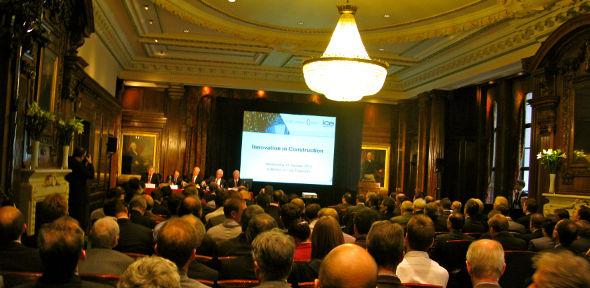
The construction industry is under pressure to improve cost efficiency and sustainability and is innovating at a pace not seen since the industrial revolution, but there are opportunities to do more. This was the key message of a recent meeting held by The Royal Academy of Engineering on Innovation in Construction.
The half-day event, organised by the Institution of Civil Engineers (ICE), the University of Cambridge's Centre for Smart Infrastructure and Construction and The Royal Academy of Engineering, brought together thought leaders on innovative construction techniques and emerging technologies across industry, government and academia. It was chaired by Sir John Parker and Peter Hansford.
The Government's role in encouraging innovative construction was discussed by Paul Morrell, Chief Construction Adviser to the UK Government. He observed that "Competition in the construction industry does not work the way it should, leading to the cost of construction soaring by twice as much as the rate of inflation in recent boom times." He added, "The government can help with investment, regulation and procurement and we have set a long-term trajectory, laying out future sustainability plans so companies can plan their areas of investment. We believe we should not tell the construction industry what to do but leave it free to innovate".
The next speaker, Bill Hewlett, Technical Director of Costain, focused on the advantages of sharing innovative ideas and research, as well as risk. He saw that "Innovative building requires closer relationships between the industry and academia" and "Academia tends to be very good at thinking about first principles, but the ability to implement change lies in the industry so they have to work together." This led him to conclude that "A risk share approach and progressive design are required to innovate on complex projects where it is not possible to determine a fixed cost or end date. We need to make sure that the government procures with this in mind as private firms rarely choose to share construction risk with the builder, which can inhibit innovation."
Dr Scott Steedman, Director of Standards, British Standards Institution, said, "Tough sustainability targets and aspirational standards can promote innovation and reduce building costs, so engineers must look for opportunities to add value through more sustainable techniques and materials."
For Ray O'Rourke, Chairman and Chief Executive, Laing O'Rourke, many innovative opportunities lie in the future of house building. He has a vision of 90 percent of construction being completed off-site to boost efficiency so that a house composed of modules could be made watertight within a day.
The ability for sensor technologies to monitor infrastructure from the cradle to the grave, was discussed by Professor Robert Mair, Head of Civil and Environmental Engineering, University of Cambridge. He suggested that "This technology enables engineers to understand how infrastructure is performing during and after construction, leading to more informed decision-making and improved performance-based design and construction processes." He described the new Cambridge Innovation and Knowledge Centre for Smart Infrastructure and Construction, funded by the Engineering and Physical Sciences Research Council, the Technology Strategy Board, and a number of industry partners and outlined its role in promoting the adoption of new technologies to improve the delivery and performance of infrastructure.
"Wireless sensor networks could play a role in monitoring the deterioration of existing infrastructure" said Kenichi Soga, Professor of Civil Engineering, University of Cambridge. He explained how wireless motes with MEMS sensors inside can be easily installed in tunnels, for example, to send updates about the infrastructure's performance. He explained that "The university is also developing energy harvesting devices to power motes to create a 'self-supporting monitoring system' as well as exploring embedding fibre optics in construction materials to create a 'nervous system' in infrastructure."
Duncan McFarlane, Professor of Industrial Information Engineering, University of Cambridge, said that the information generated from sensor technology will transform construction firms into service organisations that will be able to look after infrastructure projects throughout their lifespan. He summarised the challenge as, "How to make the massive amount of data generated by sensors easily accessible as well as how to assess its value and impact?"
Finally, Dr Steve Denton, Director of Engineering, Parsons Brinckerhoff, examined the conditions which promote innovation on a construction project. He believes that innovation is not an adjunct but at the core of engineering and said that "Most innovative opportunities are found at the beginning of projects when you need a sophisticated understanding of the complex requirements of a client to find a new and better approach to building." He continued that "Collaboration across disciplines with academics and other companies creates innovation 'hotspots,' but the environment must exist to incentivise motivation and exploitation of innovations".

